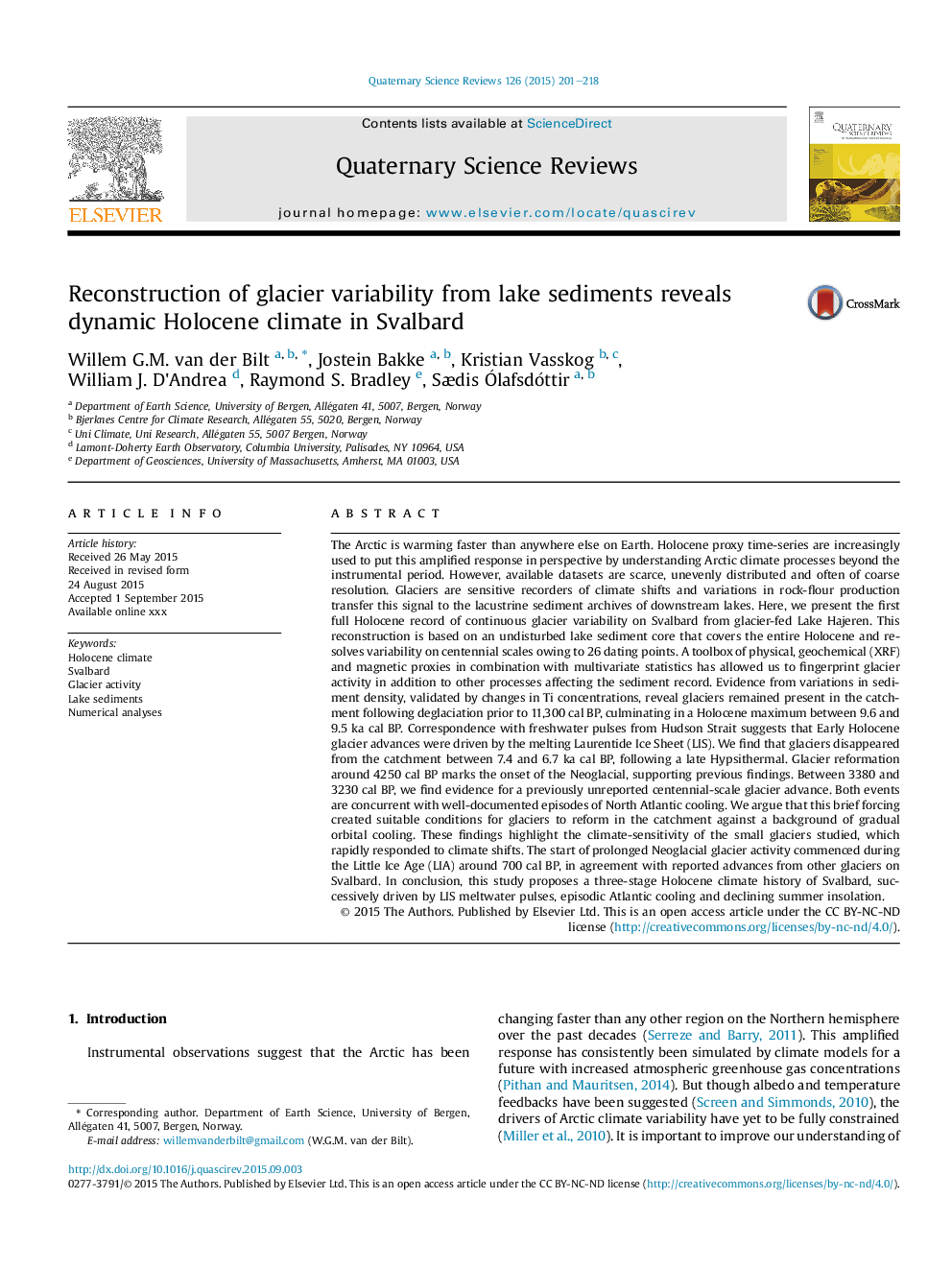| کد مقاله | کد نشریه | سال انتشار | مقاله انگلیسی | نسخه تمام متن |
|---|---|---|---|---|
| 6445834 | 1640808 | 2015 | 18 صفحه PDF | دانلود رایگان |
عنوان انگلیسی مقاله ISI
Reconstruction of glacier variability from lake sediments reveals dynamic Holocene climate in Svalbard
ترجمه فارسی عنوان
بازسازی تغییرات یخبندان از رسوبات دریاچه، آب و هوای پویا هولوسن در اسلب آباد را نشان می دهد
دانلود مقاله + سفارش ترجمه
دانلود مقاله ISI انگلیسی
رایگان برای ایرانیان
کلمات کلیدی
موضوعات مرتبط
مهندسی و علوم پایه
علوم زمین و سیارات
زمین شناسی
چکیده انگلیسی
The Arctic is warming faster than anywhere else on Earth. Holocene proxy time-series are increasingly used to put this amplified response in perspective by understanding Arctic climate processes beyond the instrumental period. However, available datasets are scarce, unevenly distributed and often of coarse resolution. Glaciers are sensitive recorders of climate shifts and variations in rock-flour production transfer this signal to the lacustrine sediment archives of downstream lakes. Here, we present the first full Holocene record of continuous glacier variability on Svalbard from glacier-fed Lake Hajeren. This reconstruction is based on an undisturbed lake sediment core that covers the entire Holocene and resolves variability on centennial scales owing to 26 dating points. A toolbox of physical, geochemical (XRF) and magnetic proxies in combination with multivariate statistics has allowed us to fingerprint glacier activity in addition to other processes affecting the sediment record. Evidence from variations in sediment density, validated by changes in Ti concentrations, reveal glaciers remained present in the catchment following deglaciation prior to 11,300 cal BP, culminating in a Holocene maximum between 9.6 and 9.5 ka cal BP. Correspondence with freshwater pulses from Hudson Strait suggests that Early Holocene glacier advances were driven by the melting Laurentide Ice Sheet (LIS). We find that glaciers disappeared from the catchment between 7.4 and 6.7 ka cal BP, following a late Hypsithermal. Glacier reformation around 4250 cal BP marks the onset of the Neoglacial, supporting previous findings. Between 3380 and 3230 cal BP, we find evidence for a previously unreported centennial-scale glacier advance. Both events are concurrent with well-documented episodes of North Atlantic cooling. We argue that this brief forcing created suitable conditions for glaciers to reform in the catchment against a background of gradual orbital cooling. These findings highlight the climate-sensitivity of the small glaciers studied, which rapidly responded to climate shifts. The start of prolonged Neoglacial glacier activity commenced during the Little Ice Age (LIA) around 700 cal BP, in agreement with reported advances from other glaciers on Svalbard. In conclusion, this study proposes a three-stage Holocene climate history of Svalbard, successively driven by LIS meltwater pulses, episodic Atlantic cooling and declining summer insolation.
ناشر
Database: Elsevier - ScienceDirect (ساینس دایرکت)
Journal: Quaternary Science Reviews - Volume 126, 15 October 2015, Pages 201-218
Journal: Quaternary Science Reviews - Volume 126, 15 October 2015, Pages 201-218
نویسندگان
Willem G.M. van der Bilt, Jostein Bakke, Kristian Vasskog, William J. D'Andrea, Raymond S. Bradley, Sædis Ãlafsdóttir,
